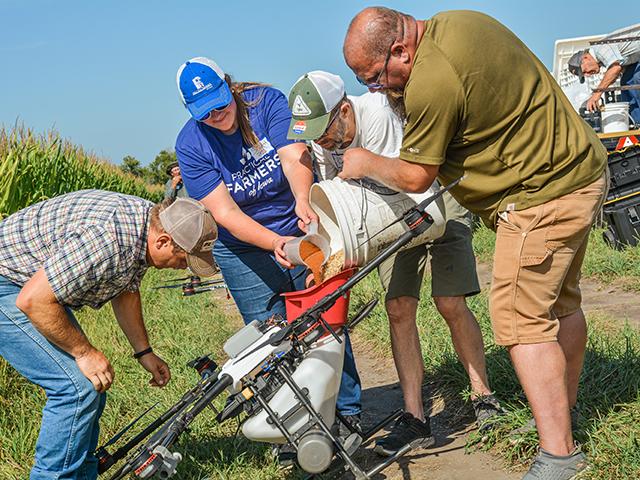Conservation on Leased Acres Requires Collaboration
Team Up for Conservation
Lee Tesdell values soil health and water quality more than getting top dollar when cash-renting his family's central-Iowa farm.
The retired educator likes to make a buck, but not at the expense of the environment and land his great-grandfather bought in 1884, near Slater. In exchange for using conservation practices like cover crops and no-till, Tesdell gives farmers Mike and Charles Helland a break on the cash rent rate. And, the brothers can lease the property for as long as they want.
"I want these guys to make money. My long-term goal is to clean up the tile water leaving the farm and increase soil health," Tesdell says, noting farmers are less likely to help with conservation efforts if cash rent is too high, and the land goes up for bid annually. Cooperation is "the only way forward that I can see."
RELATIONSHIPS MATTER
Tesdell and the Helland brothers say their mutually beneficial partnership, which has flourished for nearly four decades, is built on communication, friendship and trust. Tesdell's father, Loren, initially rented the farm to the Hellands, and Lee continued the relationship after purchasing the property.
They all agree establishing common goals is a must. Tesdell wants to make money renting tillable acres, which he reinvests to make further improvements to keep soil productive for future generations. Profit potential is the main priority for the Hellands. The brothers are more than willing to help Tesdell thanks to a reasonable cash rent rate. Plus, the Hellands believe in environmental stewardship, as well.
Tesdell and the Hellands declined to share details of the annual per-acre rent, which Tesdell adjusts based on commodity prices and input costs. But, it's under the going rate where cash rent in Polk County averaged $245 per acre in 2021, according to the Iowa State University annual cash rental rate survey.
P[L1] D[0x0] M[300x250] OOP[F] ADUNIT[] T[]
"Lee is a little different than a lot of landlords, since he's actively engaged in conservation projects," Mike Helland says. "If the rent is high, and you don't know how long you're going to have [the land], you are not going to spend any money and time taking care of it."
Since 40% of U.S. farmland is rented, according to the U.S. Census of Agriculture, landowner-tenant collaboration is vital to achieve the water-quality goals of many environmental programs and soil-health initiatives across the country.
Mike Naig, Iowa secretary of agriculture, co-chairs the Gulf of Mexico Hypoxia Task Force. Working across 12 states, the group's goal is to reduce nutrient pollution in the Mississippi/Atchafalaya River Basin. Nutrient runoff from farms, mostly nitrogen and phosphorus, make their way into waterways and, eventually, the Mississippi River, which empties into the Gulf of Mexico. The pollutants are primarily responsible for a hypoxic "dead" zone that's largely void of aquatic life because of lack of oxygen in the water.
Naig has visited Tesdell's farm -- a popular spot to host conservation field days -- which showcases how conservation efforts coexist with crop production. In- and edge-of-field conservation practices on the property, which take up 10 acres, include grass waterways, terraces, three saturated buffers, three prairie strips and an underground woodchip bioreactor. No-till and cover crops are part of the annual cropping plan on all 65 tillable acres. Tesdell uses 5 acres for hay production.
"I think one of the most effective ways for farmers and landowners to learn about conservation practices and encourage adoption is to talk to other farmers and landowners to learn from them," Naig adds.
Iowa's ag leader encourages all landowners and tenants to follow the lead of Tesdell, the Hellands and others like them to cooperatively work together to ramp up conservation adoption. "[Tesdell-Hellands partnership] is a good example of how this can work," he says.
SEEING IS BELIEVING
Tesdell, the Hellands and three local conservation groups teamed up late last summer to demonstrate how cover crops and saturated buffers improve water quality on Tesdell's farm. Cover crops build soil organic matter and sequester nutrients. Saturated buffers are areas of perennial vegetation between crop fields and waterways into which tile outlets drain, which filter pollutants from the water.
As a result, Tesdell says harmful nutrient runoff from the farm is extremely low. Testing by the Iowa Soybean Association (ISA) shows nitrate levels of water treated by saturated buffers and bioreactors on the farm are usually 3 to less than 1 part per million (ppm). The federal drinking water standard is 10 ppm. The nitrate load in Alleman Creek, which Tesdell's land and drainage tile drains into, averages 11 to 12 ppm, according to ISA data.
"If the landlord is reasonable on the rent and wants you [tenant] to make money, you will be more apt to ... work with them on conservation efforts like cover crops," Mike Helland explains. "Ultimately, the landlord benefits from long-term care of the land, but the tenant does, too."
Tesdell says the partnership has morphed into a close friendship, noting the men talk regularly about the farm and ways to improve it.
"I have both on speed dial," he quips. "The better relationship you have ... the more apt the tenant will treat your land like their own."
**
-- For Iowa farmland rental and lease information, visit https://www.extension.iastate.edu/…
-- Follow the latest from Matthew Wilde, Crops Editor, by visiting the Production Blogs at https://www.dtnpf.com/… or following him on Twitter @progressivwilde
[PF_0822]
(c) Copyright 2022 DTN, LLC. All rights reserved.




